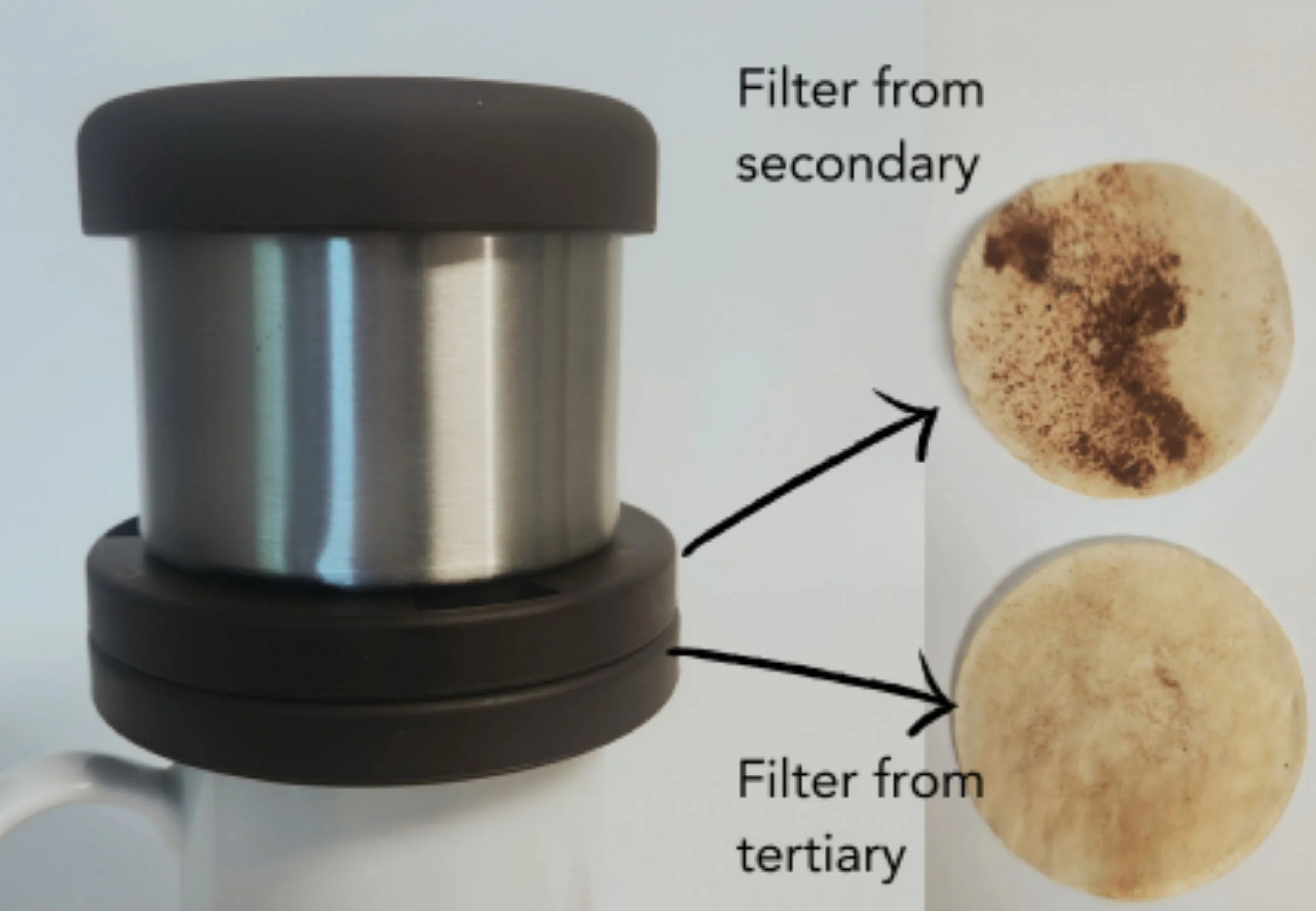Post-extraction Filtration - No Stalled Brews!
Classical Pour-Over Filters: Three Functions
In 1908, when Melitta Bentz placed loose coffee onto a paper filter, she unknowingly created a design pattern that would persist for over a century. That paper filter was asked to fulfill three distinct roles—all of which are still present in most coffee pour-over and drip brewers today:
Contain the grounds - Hold the coffee in place, preventing it from falling into the brewing vessel
Control flow rate - Regulate water movement through its interaction with the coffee bed and slurry, directly influencing extraction
Filter the brew - Remove unwanted compounds and fine particles from the finished coffee
Here's the problem: only in the third function does the paper filter actually filter anything. In classical pour-over brewing, the paper filter is intimately involved with percolation and extraction—and that dual role creates complications.
The Main Problem: Fines Migration and Stalled Brews
While inconsistent flow rates present challenges (paper filters weren't designed to be precision flow controllers), the most significant issue with filter-coffee contact is fines migration leading to stalled brews and unpleasant coffee.
Here's what happens:
Every grinder produces a particle size distribution that includes fines—very small coffee particles that behave differently than the main grind. When water is poured onto a loose coffee bed, turbulence and agitation (sometimes intentional, sometimes not) cause these fines to migrate downward through the bed. Eventually, they reach the paper filter.
Once there, fines begin clogging the filter, progressively restricting flow. In severe cases, the filter becomes so clogged that the brew stalls entirely—water sits in extended contact with the coffee grounds, leading to over-extraction and harsh, bitter flavors.
The result: Even with quality beans and proper technique, fines migration can sabotage your brew.
The Typical Response: Work Harder
Coffee enthusiasts have developed numerous strategies to combat fines migration:
Expensive grinders that produce fewer fines
Sifting grounds before brewing (time-consuming, wasteful)
Careful pouring technique to minimize agitation
Grind coarser and accept under-extraction
All of these are workarounds for a fundamental design limitation: the paper filter is trying to do too many jobs at once.
Remote Filtration: A Different Approach
Encapsulated Pour-Over (EPO) systems, like the Simple Smart Coffee Brewer, separate these functions architecturally.
The paper filter has one job: clarification. Rather than being in direct contact with the coffee grounds, the filter is positioned downstream of the extraction process, separated by an air gap.
[Insert Image: SSC Brewer cross-section showing expanded coffee bed, air gap, and downstream paper filter]
In this design:
The brewer body and filter plate handle extraction and primary containment
The expanded coffee bed holds fines in place
The paper filter (downstream) handles only final clarification
This separation of functions—with extraction happening upstream and filtration happening downstream—represents a fundamental architectural difference from classical pour-over, where the paper filter must perform multiple roles simultaneously.
Simple Smart Coffee Brewer - Air Gap Between Paper Filter and Coffee Bed
Why Does This Matter?
Stable Coffee Bed Prevents Fines Migration
EPO maintains a stable, expanded coffee bed rather than a dynamic slurry. Some people say "the coffee bed is the best filter"—but that's a bit of a misnomer. The bed isn't actually filtering anything out; only water enters from above.
What the stable bed does is prevent fines from migrating in the first place. Most fines remain trapped within the expanded coffee structure. The few that do escape are captured by the paper filter downstream.
Filtration Can't Affect Extraction
Here's the key advantage: even if significant fines reach the paper filter and slow its flow, this cannot affect percolation through the coffee bed because the bed and filter are separated.
In classical pour-over:
Fines clog filter → water backs up into coffee bed → extraction stalls → bad coffee
In EPO:
Fines reach filter → filter flow slows → extraction continues normally → coffee still tastes good
The paper filter's performance is decoupled from the extraction process.
Overflow Protection: The Ultimate Failsafe
What if the paper filter becomes completely clogged? In classical pour-over, this means disaster—a stalled brew and ruined coffee.
The SSC Brewer includes overflow holes in the filter holder. Even in the extreme case where the paper filter is entirely blocked, water simply passes through these overflow holes instead. Your coffee continues to brew normally.
This means the paper filter literally cannot stall your brew, regardless of how many fines reach it or how fine your grind is.
Optional Enhanced Filtration
For those who want exceptionally clean, clear coffee—or are working with particularly fine-producing grinders—filter adaptors can be stacked to create additional filtration stages. Each stage with its own paper filter provides progressive clarification while maintaining the overflow protection that prevents stalling.
Multiple filtration stages offer:
Ultra-clean cup profile (minimal sediment or oils)
Additional margin for very fine grinds
Flexibility to tune clarity vs. body to your preference
The overflow design ensures that even multi-stage filtration can't compromise your extraction.
Stacked Filters - Simple Smart Coffee Brewer
Better Coffee with Entry-Level Equipment
This design makes the brewing process more forgiving:
Entry-level grinders become viable—fines are held in place regardless
Pour technique becomes less critical—agitation doesn't cause migration problems
Filter clogging is impossible—overflow holes provide failsafe drainage
Consistency improves—fines can't randomly stall your brew
Optional clarity control—stack filters for cleaner cups when desired
Focus shifts from fighting fines to optimizing flavorcus on what matters: great-tasting coffee.


